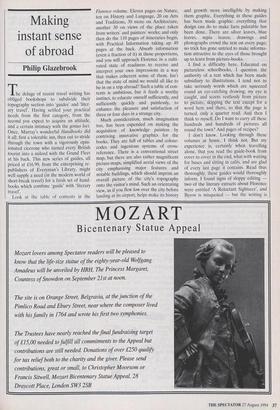Making instant sense of abroad
Philip Glazebrook
The deluge of recent travel writing has obliged bookshops to subdivide their topography section into 'guides' and 'liter- ary travel'. Having settled your practical needs from the first category, from the second you expect to acquire an attitude, and a certain intimacy with the genius loci. Once, Murray's wonderful Handbooks did it all: first a tolerable inn, then out to stride through the town with a vigorously opin- ionated cicerone who turned every British tourist into a milord with the Grand Fleet at his back. This new series of guides, all priced at £16.99, from the enterprising re- publishers of Everyman's Library, might well supply a need (in the modern world of short-break travel) for a fresh set of hand- books which combine 'guide' with 'literary travel'.
Look at the table of contents in the
Florence volume. Eleven pages on Nature, ten on History and Language, 20 on Arts and Traditions, 30 more on Architecture, another 30 on views of the place taken from writers' and painters' works; and only then do the 110 pages of itineraries begin, with Practical Information taking up 40 pages at the back. Absorb information (even a fraction of it) in those proportions, and you will approach Florence in a culti- vated state of readiness to receive and interpret your own impressions in a way that makes coherent sense of them. Isn't that the state of mind we would all like to be in on a trip abroad? Such a table of con- tents is ambitious, but it feeds a worthy instinct, to educate oneself sufficiently, and sufficiently quickly and painlessly, to enhance the pleasure and satisfaction of three or four days in a strange city.
Much consideration, much imagination too, has been expended on making the acquisition of knowledge painless by contriving innovative graphics for the books. They are full of tables and colour- codes and ingenious systems of cross- reference. There is a conventional street map, but there are also rather magnificent picture-maps, simplified aerial views of the city emphasising major features and notable buildings, which should imprint an overall picture of the city's topography onto the visitor's mind. Such an orientating view, as if you flew low over the city before landing at its airport, helps make its history and growth more intelligible by making them graphic. Everything in these guides has been made graphic: everything that design can do to make facts palatable has been done. There are silver leaves, blue leaves, sepia leaves; drawings and photographs crowd the text on every page; no trick has gone untried to make informa- tion attractive to the eyes of those brought up to learn from picture-books.
I find a difficulty here. Educated on pictureless schoolbooks, I question the authority of a text which has been made subsidiary to illustrations. I tend not to take seriously words which are squeezed round an eye-catching drawing; my eye is caught, and scoots restlessly from picture to picture, skipping the text except for a word here and there, so that the page is turned, only a quarter read. And then I think to myself, Do I want to carry all these hundreds and hundreds of pictures all round the town? And pages of recipes?
I don't know. Looking through these volumes at home, I think not. But my experience is, certainly when travelling alone, that you read the guide-book from cover to cover in the end, what with waiting for buses and sitting in cafés, and are glad of every last page it contains. Read thus thoroughly, these guides would thoroughly inform. I found signs of sloppy editing two of the literary extracts about Florence were entitled 'A Reluctant Sightseer', and Byron is misquoted — but the writing is succinct and authoritative. Though the series' ambition, to be 'both a guide and an art book in miniature', makes the volumes heavy, I believe they would pull their weight on site. I shall certainly take one with me next time I go to a city on their extensive and expanding list.



























































 Previous page
Previous page